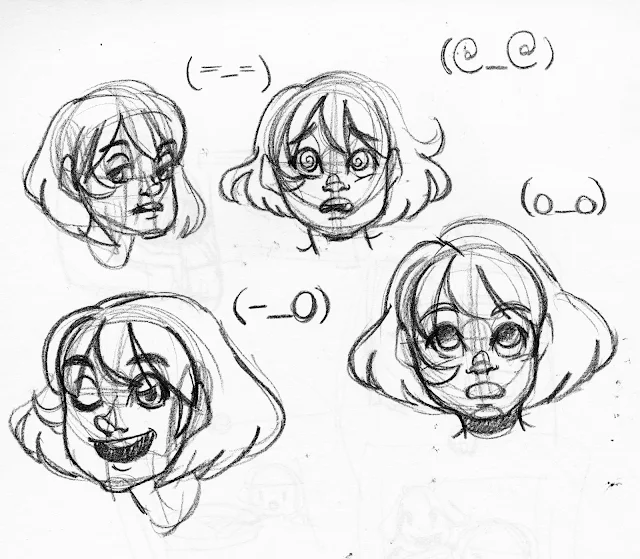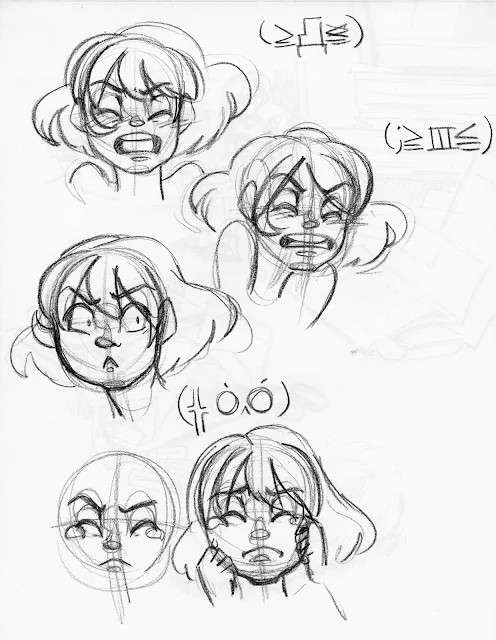Character Expression: Intro to Comic Craft, Step by Step
Read 7" Kara as a webcomic!
In our last Intro to Comic Craft: Step by Step: Roughs, we explored body language and character acting. While body language and character acting are important, and a vital part of storytelling, body language is half the equation. Expression is a vital part of storytelling that should be explored, and it's often the aspect that is the most fun for artists.
This post was brought to you by Ink Drop Cafe, a creator's collective! Swing by to sample our wonderful selection of comics (including 7" Kara!), as well as our fantastic artist resources such as Kabocha's Photoshop and Clip Studio Paint Brushes
Although body language/character acting and expression are similar, they are not the same. Think of expression as a micro-action in body language- the icing on the cake.
In the above example, the top illustration of Kara shows character acting that only involves expression and the hands. While the expression is readable, it isn't nearly as clear as the bottom illustration, which utilizes the arms and hair, in addition to the face and hands to push the expression.
While body expression focuses on the entire body (or as much body as is shown in the pane), expression focuses mainly on the head- the eyes, ears, nose, mouth, eyebrows, and even hair. Expression can also include neck and shoulders, but I consider those to be more body acting.
While body expression focuses on the entire body (or as much body as is shown in the pane), expression focuses mainly on the head- the eyes, ears, nose, mouth, eyebrows, and even hair. Expression can also include neck and shoulders, but I consider those to be more body acting.
We discussed expression and body movement earlier in the Intro to Comic Craft: Step by Step series in the Brainstorming post, so some of these exercises may be familiar to you. These are helpful to keep on hand, because many will work well for your characters, and they're a great reference when you're feeling a bit tapped for ideas.
Check out the Brainstorming post for more character development exercises!
Blank Face Template
Patrons have access not only to the PSD of this file, but also have access to my Chibi drawing templates, as well as practice sheets for Child, Female, and Male head bases.
Templates like this are a great way to practice drawing facial expressions.
The Basics of Facial Expression
Neutral Face:
Happiness:
Anger:
Scared/Surprised:
Sadness:
Source: Cartoon Fundamentals: Create Emotions from Simple Changes in the Face
Below are a few of my favorite examples from various kaomoji exercises.
Blank Face Template
Patrons have access not only to the PSD of this file, but also have access to my Chibi drawing templates, as well as practice sheets for Child, Female, and Male head bases.
Templates like this are a great way to practice drawing facial expressions.
The Basics of Facial Expression
Neutral Face:
Happiness:
Anger:
Scared/Surprised:
Sadness:
Source: Cartoon Fundamentals: Create Emotions from Simple Changes in the Face
Below are a few of my favorite examples from various kaomoji exercises.
I tried to use a mix of comic shorthand and realistic interpretation in my exercises, to find expressions that felt real, if they didn't necessarily look realistic.
In the Body Language and character acting post, I mention using hands as part of your character acting. As you can see in the expression studies above, I really tried to push hand action whenever possible.
In roughs and thumbnails:
Expression is important for animals, especially in cartoony comics, or comics aimed at kids.
Whenever reasonable, I try to use over exaggerated expressions for humor, as in this shot of Kara daydreaming about sweets from Chapter 7.
Since 7" Kara is aimed at kids, I wanted to make sure expression and body language were clear enough that a non-reader could follow the main beats of the story, even if they didn't understand the finer details.
Expression and Emotion on Simplified Characters
Even with simplified features, expression can be clearly conveyed. It may be necessary to push the expression further, but this can be a fun exercise as well.
These little watercolor expressions were inspired by Line-Tool emoji stickers, and were a fun exercise.
Expression Demonstrated in Finished 7" Kara Pages
Outside Resources:

































Comments
Post a Comment